Is technology keeping kids glued to screens indoors? Are we sacrificing physical play for digital progress? Can early education leaders like us find a balanced solution that blends innovation with movement? If you’re a kindergarten director or school owner, you’re likely asking the same questions—especially as parents and educators become more concerned with children’s screen time and physical activity levels.
Outdoor tech activities help kids learn coding, robotics, energy, and nature science—all while staying active and safe in the fresh air. These tech activities outdoor for kids allow children to touch, move, experiment, and play with technology beyond the limits of a classroom. They’re essential tools to nurture curiosity, problem-solving, and social interaction. Most importantly, these outdoor tech activities promote 21st-century skills while supporting physical health.
Today, I want to share 10 tech activities outdoor for kids that combine technology with motion, fun with education, and innovation with nature. You’ll learn how to integrate these tech activities into your kindergarten program while enhancing both learning outcomes and parental satisfaction.
Why Tech Activities Outdoor for Kids Are So Important
In early childhood education, technology should never mean sitting still in front of a screen. For children, learning is movement. Touching. Exploring. Questioning. That’s why tech activities outdoor for kids are not just an alternative—they’re a necessity.
When we move tech learning outdoors, we unlock deeper engagement. Children aren’t just passive consumers of information; they’re builders, testers, and storytellers. An outdoor setting encourages kids to combine technology with physical activity, stimulating both mind and body in harmony. Tech activities outdoor for kids enable active learning and improve attention spans.
Outdoor tech activities also solve several pain points for educators and school owners:
They reduce excessive screen time.
They fulfill developmental needs for gross motor skill-building.
They support multi-sensory and inquiry-based learning.
They enhance social interaction through team-based problem-solving.
For kindergartens, adopting outdoor tech is a strategic advantage. Parents want environments where children thrive both mentally and physically. Outdoor tech setups help schools stand out by integrating STEM principles in creative, age-appropriate ways. They also align with emerging educational models that prioritize hands-on, exploratory learning in open environments. These tech activities outdoor for kids create a competitive edge.
International research confirms the benefits of combining outdoor learning and STEM experiences. Studies show improvements in focus, retention, creativity, and emotional regulation when students engage with interactive tech outside the classroom walls.
By embracing this dual approach—technology plus nature—we meet children’s developmental needs while preparing them for a future driven by innovation. And we do it all without compromising on movement, fun, or safety. Tech activities outdoor for kids are a bridge between digital skills and natural exploration.
10 Tech Activities Outdoor for Kids
Now let’s explore 10 powerful outdoor tech activities that bring this philosophy to life.
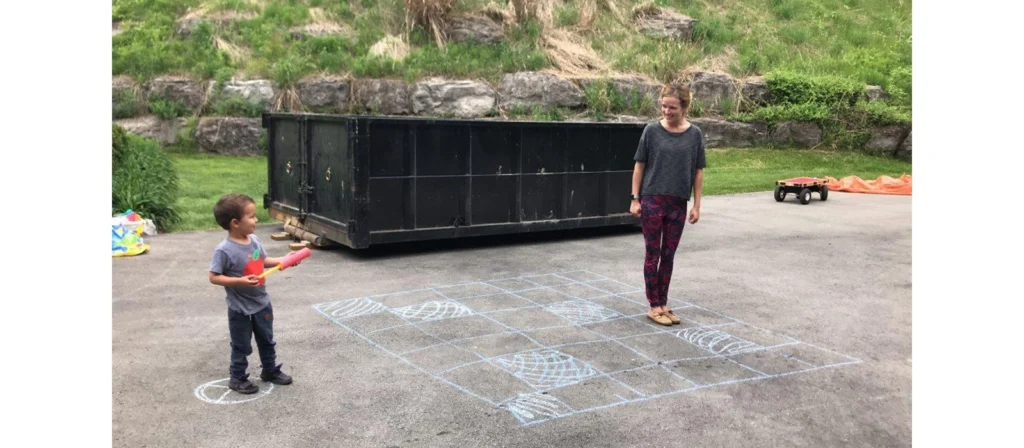
1. Outdoor Coding Games with Physical Sensors
One of the most effective ways to teach young children coding concepts is through physical, hands-on games. Outdoor coding activities that use programmable robots or sensor-based toys combine movement, logic, and collaboration into a single experience. These tech activities outdoor for kids bring coding concepts into a physical, dynamic environment.
For example, robots like KIBO, Cubetto, or Code & Go Robot Mouse are designed specifically for early learners. These tools don’t require screens or keyboards. Instead, children lay out a sequence of commands using wooden blocks or directional cards. They then physically move the robots across large mats or outdoor grids designed with obstacles, tasks, or themed stories.
Why do these work so well outdoors? Because children have room to move! On grass fields, playgrounds, or paved paths, educators can lay down chalk paths or use portable mats with mazes. Kids form teams to plan, test, and debug their robot’s route. This interaction enhances communication, social learning, and real-time problem-solving.
These types of physical coding experiences support foundational STEM skills—pattern recognition, logical sequencing, and cause-and-effect understanding—all through active play. They also foster leadership and empathy, especially when children take turns and help each other solve challenges.
To get started, schools need only a basic coding robot set, outdoor space, and themed activity prompts. Laminated story cards, themed missions (like “rescue the animal” or “find the treasure”), and minimal tech setup make it low-cost and high-impact.
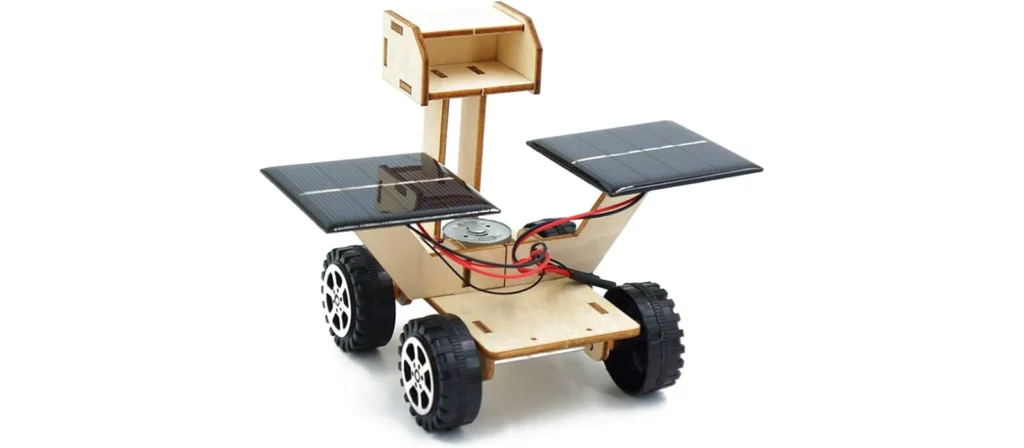
2. Solar-Powered Science Experiments
Children are naturally curious about the world around them, and what better way to spark that curiosity than through the power of the sun? Solar-powered science experiments are an excellent outdoor tech activity that introduces children to energy concepts, environmental science, and engineering in an accessible, hands-on way. These solar-based tech activities outdoor for kids teach real-world applications of renewable energy.
Using simple solar kits—such as solar cars, water pumps, ovens, and fans—kids can assemble devices that come to life under sunlight. These kits are often designed with large parts and minimal tools, making them safe and suitable for children as young as 4 or 5. When the sun hits the panel and the fan spins or the wheels start moving, kids experience science in real time.
The outdoor setting enhances the learning experience by letting children observe how environmental factors affect energy production. Is the car moving slower under shade? What happens when we tilt the panel? These real-world conditions create authentic opportunities to experiment, make predictions, and analyze outcomes.
Kindergartens can incorporate solar science into themed days such as “Eco Week” or “STEM in Nature.” Create small science stations in your school yard with labeled solar gadgets. Let children rotate through them and record what they observe. These tech activities outdoor for kids can also be used to complement green campus initiatives.
Incorporating these activities also strengthens the school’s environmental education image, which is increasingly important to modern parents who value sustainability.

3. Nature + Tech Scavenger Hunt with Tablets
Combining digital technology with outdoor exploration, a tech-enhanced scavenger hunt is a fun and educational way to engage young learners. These tech activities outdoor for kids integrate AR (augmented reality), GPS tracking, and educational apps to turn a simple nature walk into a mission-based adventure.
Using rugged tablets or child-safe devices, children follow digital clues that lead them to various locations around the schoolyard or nearby park. At each stop, they may be prompted to identify a leaf, take a photo of an insect, or watch an AR animation about local wildlife. Some apps even let educators create custom scavenger hunts tied to classroom themes like “The Four Seasons” or “Eco Explorers.”
This activity builds tech fluency and scientific observation skills while encouraging movement, teamwork, and problem-solving. Children work in pairs or small groups, using their devices as interactive field guides. The digital element adds excitement and novelty while the outdoor setting ensures physical engagement.
Educators can extend this by having students present their discoveries using slideshow apps or photo journals. These scavenger hunts are adaptable, cost-effective, and align well with environmental studies and STEM standards.

4. Programmable Outdoor Robots
Programmable outdoor robots take tech activities outdoor for kids to an advanced level by introducing elements of automation, problem-solving, and real-world robotics. Unlike indoor robots that operate in confined spaces, these outdoor-friendly versions are built for more rugged environments—like playgrounds, grass fields, and paved schoolyards.
Examples include robots like Dash, Sphero BOLT, and RVR, which can be programmed using apps via Bluetooth and designed to move around different terrains. With visual drag-and-drop coding interfaces, even 5-year-olds can create simple sequences to navigate a robot through cones, tunnels, or obstacle courses.
Outdoor programmable robot activities can be adapted into races, treasure hunts, or team challenges. Teachers can mark routes with flags or cones and encourage students to estimate distances, program turns, and debug commands. These activities strengthen spatial reasoning, logical thinking, and perseverance.
Importantly, kids get to see how their code directly affects the robot’s physical movement—reinforcing the connection between the digital world and the physical environment. The process also encourages collaborative troubleshooting and sharing ideas with peers.
This type of activity works well for project-based learning and is ideal for after-school STEM clubs, summer camps, or outdoor education days. Just ensure that robots chosen are weather-resistant and have protective casings.
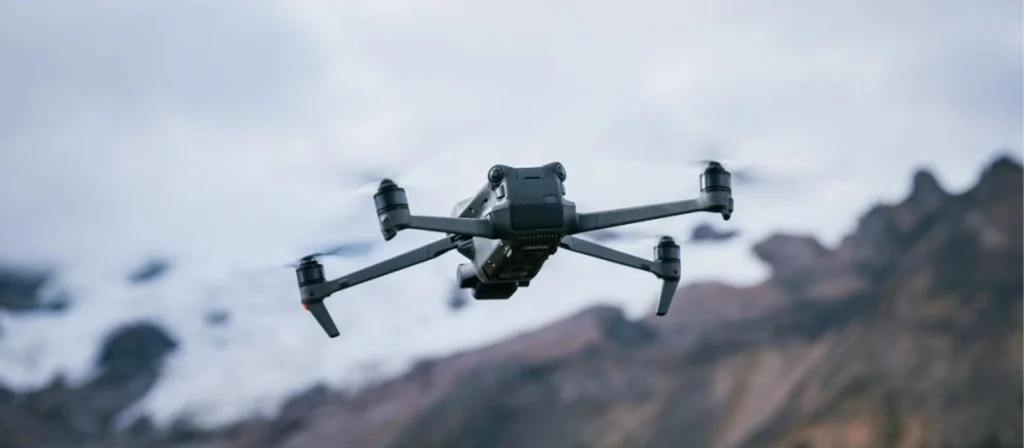
5. Drone Flying Activities with Safety Gear
Drone flying may sound like an advanced skill, but even preschool-aged children can safely engage in this thrilling tech activity with the right equipment and adult supervision. These tech activities outdoor for kids offer excitement, STEM learning, and valuable lessons in responsibility and spatial awareness.
Lightweight, child-friendly drones—such as the Holy Stone HS210 or Potensic A20—are ideal for young beginners. These drones come with simple controls, one-key takeoff/landing, and altitude hold, making them easy to handle in outdoor environments like large playfields or open schoolyards.
Before flying begins, educators should lead a quick lesson on drone parts, controls, and safety rules. Include topics like weather conditions, safe distances, no-fly zones, and respecting others’ space. Providing kids with flight goggles, safety cones, and simple air traffic signals makes the experience even more immersive and structured.
The learning outcomes are significant: kids enhance their motor coordination, understand basic physics of flight, and improve decision-making and concentration. Many schools integrate drone flying into lessons on navigation, geography, or even photography by attaching lightweight cameras.
To reduce risk, always supervise activities and limit drone use to certified models designed for children. Keep groups small and rotate flight turns to ensure safety and engagement.
These drone tech activities outdoor for kids are not only thrilling—they also prepare children for an increasingly aerial-tech future.

6. Tech-Enhanced Gardening with Sensors
Gardening is already a fantastic educational tool for young children—but when paired with modern sensor technology, it becomes one of the most engaging tech activities outdoor for kids. By integrating soil moisture meters, sunlight sensors, and app-connected thermometers, kindergartens can turn a regular garden into a smart learning lab.
Children can plant seeds and use digital sensors to monitor the environment. They’ll learn to track sunlight exposure, detect water levels, and analyze temperature changes. Some kits even connect with mobile apps that provide growth projections and alert students when their plant “needs help.”
This activity introduces children to concepts like cause and effect, environmental responsibility, and data-driven thinking—all through tangible, real-world experiences. It also cultivates patience, empathy, and an appreciation for nature.
These tech activities outdoor for kids support cross-disciplinary learning: science, technology, math, and even language arts as students journal or draw their observations. Plus, they’re scalable—from small flower pots to full garden beds, schools can adapt these setups to match their space and budget.
Gardening with tech is also a great way to involve parents and the community. Send home weekly “growth reports,” host a “garden open day,” or even integrate smart gardening into sustainability education.
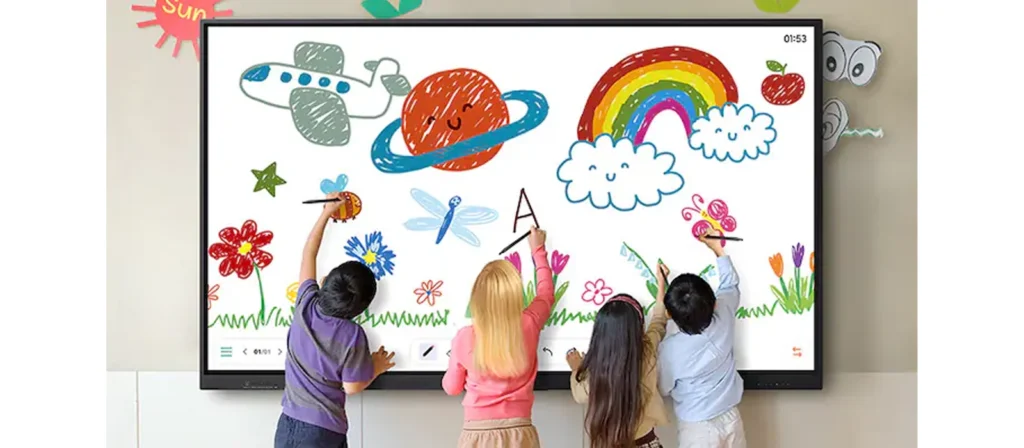
7. Interactive Digital Whiteboards for Outdoor Learning
One of the most flexible and immersive tech activities outdoor for kids is the use of interactive digital whiteboards in open-air learning zones. These mobile, weather-resistant digital boards can be wheeled into courtyards or garden areas, allowing children to interact with visual content while enjoying sunlight and fresh air.
Outdoor digital whiteboards can be used for drawing, storytelling, group games, math challenges, and even live science demonstrations. Many models are compatible with stylus pens and touch gestures, making them intuitive for young children to use. Teachers can display animations, write interactive lessons, or invite kids to complete digital puzzles right in nature.
This kind of tech activity outdoor for kids encourages multi-sensory learning by blending visual, auditory, and tactile input in a social setting. It also breaks the association between “screens” and sedentary indoor habits—turning them into collaborative tools for movement-based learning.
For kindergartens, investing in a weatherproof interactive board is a smart move. Combine it with shade sails, benches, and rugged tabletops to build a dynamic outdoor classroom. The flexibility allows staff to adapt lessons to various age groups and subjects while maintaining engagement.
Digital whiteboards also support inclusive education. Children with language delays or learning differences often benefit from the visual support and hands-on features.

8. STEM Construction Kits in the Open Air
For children, building is more than fun—it’s a pathway to understanding how the world works. That’s why STEM construction kits are powerful tech activities outdoor for kids, offering them the chance to develop engineering, math, and problem-solving skills in an open, energetic environment.
Outdoor settings are ideal for these kits, as they provide more room for large-scale structures. Whether it’s magnetic tiles, foam blocks, or solar-powered building sets, kids can work in groups to build bridges, towers, or entire pretend cities using real-world thinking. Combining kits with simple machines or weather sensors makes these tech activities outdoor for kids even more interactive.
Teachers can assign tasks like “build the tallest tower that can withstand wind,” encouraging both critical thinking and teamwork. Children collaborate naturally, sharing strategies and testing theories. The hands-on process encourages deeper learning and supports cognitive development across multiple domains.
For younger students, educators can set up building zones with basic gear. For older kids, more complex kits with coding elements or motorized parts can be used to spark advanced curiosity.
These kits are versatile, reusable, and promote active learning. Schools can rotate kits by theme—transportation one week, sustainability the next—making outdoor STEM building a regular feature of the curriculum.

9. Outdoor Photography & Video Projects
One of the most creative and expressive tech activities outdoor for kids involves giving them tools to document the world around them. Outdoor photography and video storytelling are ideal for developing communication skills, visual literacy, and an appreciation for nature—all through the lens of technology.
Children can use kid-friendly digital cameras, action cams, or tablets to take pictures of flowers, insects, classmates, and playgrounds. These tech activities outdoor for kids become meaningful when paired with thematic prompts like “a day in the life of a butterfly” or “find five things that make you smile.”
For video projects, kids can record nature documentaries, re-enact short stories, or create guided tours of their school garden. Teachers can compile these into classroom showcases, digital scrapbooks, or mini film festivals, giving students an audience and purpose.
This activity not only improves storytelling and narrative sequencing but also introduces basic tech concepts like camera handling, lighting, and editing. Use simple, child-friendly software like Clips or iMovie to stitch together clips.
More importantly, these photo and video-based tech activities outdoor for kids encourage mindfulness, empathy, and observation skills. They see the world differently when they’re behind a lens.
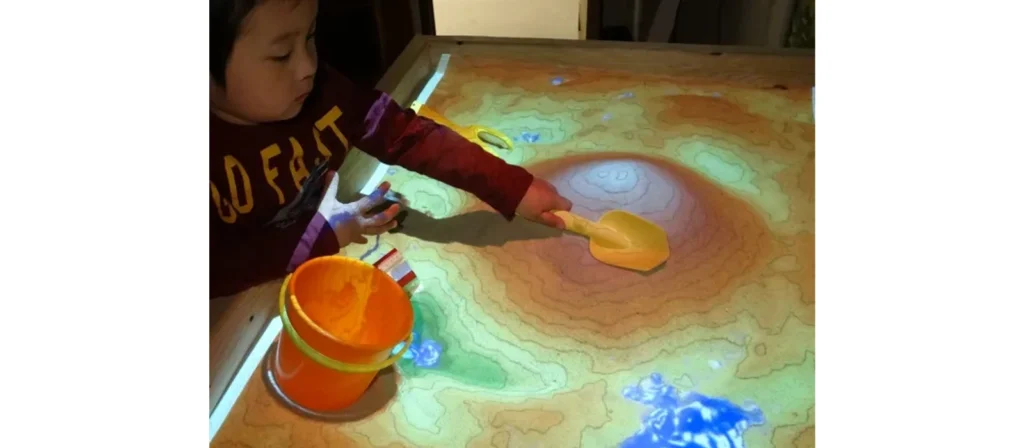
10. Augmented Reality Sandbox Play
Among the most immersive tech activities outdoor for kids is the augmented reality (AR) sandbox—a hands-on learning station where children interact with shifting landscapes that come alive through projection and depth-sensing technology.
These setups typically involve a physical sandbox paired with an overhead projector and a motion sensor like Microsoft Kinect. As kids mold the sand into hills, valleys, or rivers, the AR system detects changes and projects real-time topographic visuals—such as water flow, elevation coloring, or erupting volcanoes.
What makes this one of the most unique tech activities outdoor for kids is that it fuses physical activity, scientific inquiry, and digital interaction. Children can experiment with erosion, flooding, and landform creation in a way that’s tactile, visual, and highly engaging.
AR sandbox play fosters spatial intelligence, cause-and-effect reasoning, and collaborative exploration. It supports key science concepts tied to geography, geology, and environmental awareness—all while letting kids dig, build, and move naturally.
While full AR sandbox systems may require more investment, they can be sourced from educational tech providers or custom-built using open-source instructions. Many kindergartens choose to partner with STEM labs or local tech hubs for access.
To make the most of this activity, consider pairing it with themed weeks (like “Earth Science Week”) or integrate it into project-based learning initiatives.
These advanced tech activities outdoor for kids bring futuristic learning into the present—and do so with plenty of dirt, joy, and wonder.
How to Integrate Tech Activities Outdoor for Kids into Your Kindergarten Curriculum
Implementing tech activities outdoor for kids doesn’t require a complete curriculum overhaul. It starts with identifying your learning goals and choosing activities that align with your teaching themes. For instance, use coding games during math sessions, solar experiments for science units, or AR sandboxes for earth science weeks.
You can integrate these activities into morning rotations, special project days, or outdoor stations. Consider structuring the schedule to include a weekly “Tech in Nature” session where kids rotate through 2–3 tech-based stations outdoors. These tech activities outdoor for kids thrive on consistency, freedom to explore, and educator support.
Collaboration between teachers is key. Encourage team planning around shared equipment and outdoor spaces. Involve parents by sharing updates and inviting them to see tech learning in action through events or open houses.
Schools should also consider training sessions or workshops so staff become comfortable with the equipment and understand how to scaffold learning through technology. When teachers feel confident, the outcomes for students improve dramatically.
The beauty of tech activities outdoor for kids lies in their adaptability—they can enhance any topic, support differentiated instruction, and increase student motivation in ways traditional learning sometimes can’t.
What to Consider When Choosing Tech Activities Outdoor for Kids
Before purchasing or implementing tech activities outdoor for kids, it’s important to evaluate four critical areas: safety, age-appropriateness, durability, and learning value.
Safety: Always ensure that devices are weather-resistant or used under appropriate conditions. Lightweight drones, for example, must have soft propellers and auto shut-off. Interactive whiteboards should have secure bases to avoid tipping.
Age Appropriateness: Choose tools suited to the developmental stage of your students. Some coding robots are great for ages 4+, while others may require reading or math skills beyond preschool levels.
Durability: Because these tech activities happen outdoors, opt for rugged designs or protective cases. Weather-resistant materials are a must. If your climate is unpredictable, plan for pop-up tents or shaded areas.
Learning Value: Tech for tech’s sake is not enough. The best tech activities outdoor for kids build real-world skills, foster collaboration, and tie directly to curriculum standards. Look for STEM-based learning outcomes.
Lastly, always trial the equipment first. A small pilot group or one-time activity can help identify challenges before scaling to the whole school.
Conclusion
Tech activities outdoor for kids are more than fun—they’re foundational for building future-ready skills through play, movement, and innovation. From coding robots to AR sandboxes, these activities support learning goals while making education vibrant, hands-on, and deeply engaging.
At XIHA Furniture, we believe that a well-prepared environment is just as important as the curriculum. That’s why we offer durable, child-safe, and weather-resistant furniture solutions specifically designed to support outdoor learning. Whether you’re creating a tech garden, mobile STEM lab, or shaded robotics zone, we’re here to help you build it smarter, safer, and more affordably.
Together, let’s empower every child to learn and explore through the perfect balance of nature and technology.



